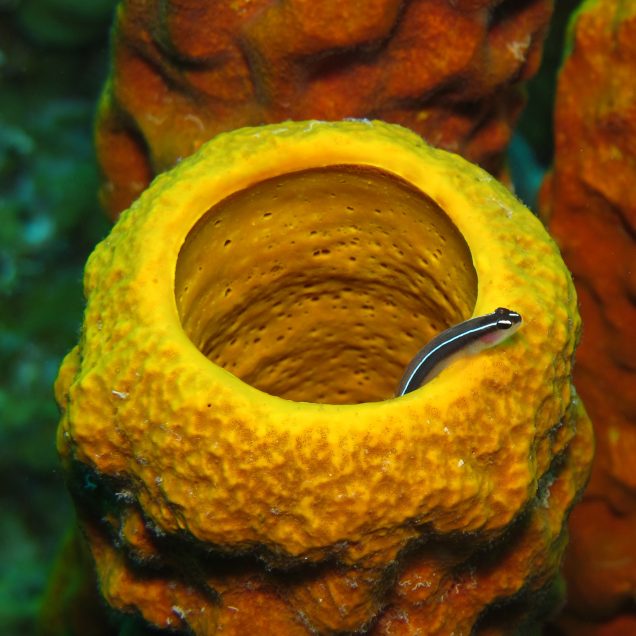Population Connectivity in Neon Gobies
 Our second line of research focuses on understanding the ecology and evolution of marine larval dispersal. Many marine organisms have a bi-partite life cycle composed of a sedentary adult phase and a dispersing larval phase. Analyzing the patterns of marine larval dispersal is central to understanding marine population dynamics, population divergence and designing effective networks of marine reserves. We have conducted some of the first quantitative investigations of larval dispersal in marine fishes: the neon goby Elacatinus lori, in Belize. We have demonstrated that the probability of successful larval dispersal declines rapidly as a function of distance from source. Our work illustrates the importance of empirically quantifying patterns of dispersal if we are to understand the spatial scale at which marine populations are connected.
Our second line of research focuses on understanding the ecology and evolution of marine larval dispersal. Many marine organisms have a bi-partite life cycle composed of a sedentary adult phase and a dispersing larval phase. Analyzing the patterns of marine larval dispersal is central to understanding marine population dynamics, population divergence and designing effective networks of marine reserves. We have conducted some of the first quantitative investigations of larval dispersal in marine fishes: the neon goby Elacatinus lori, in Belize. We have demonstrated that the probability of successful larval dispersal declines rapidly as a function of distance from source. Our work illustrates the importance of empirically quantifying patterns of dispersal if we are to understand the spatial scale at which marine populations are connected.
Relevant Publications
Lesneski, K. C. D, D’Aloia, C. C., Fortin, M-J. & Buston P. M. (2019) Disentangling spatial distributions of a sponge-dwelling fish and its host sponge. Marine Biology 166: 66.
D’Aloia, C. C., Xuereb, A., Fortin, M-J., Bogdanowicz, S, M. & Buston, P. M. (2018) Limited dispersal explains the spatial distribution of siblings in a reef fish population. Marine Ecology Progress Series 607: 143-154.
Majoris, J. D, D’Aloia, C. D, Francis, R. U & Buston, P. (2018) Differential persistence favors habitat preferences that determine the distribution of a reef fish. Behavioral Ecology 29: 429-439.
D’Aloia, C. C. D, Bogdanowicz, S. M., Francis, R. K. U, Majoris, J. D, Harrison, R. G. & Buston, P. (2015) Patterns, causes and consequences of marine larval dispersal. Proceedings of the National Academy of Sciences, USA 112: 13940-13945.
D’Aloia, C. C. D, Bogdanowicz, S. M., Majoris, J. E. D, Harrison, R. G. & Buston, P. M. (2013) Self-recruitment in a Caribbean reef fish: a new method for approximating dispersal kernels. Molecular Ecology 22: 2563-2572
D’Aloia, C. C. D, Majoris, J. E. D & Buston, P. M. (2011) Predictors of the distribution and abundance of a tube sponge and its resident goby. Coral Reefs 30: 777-786.